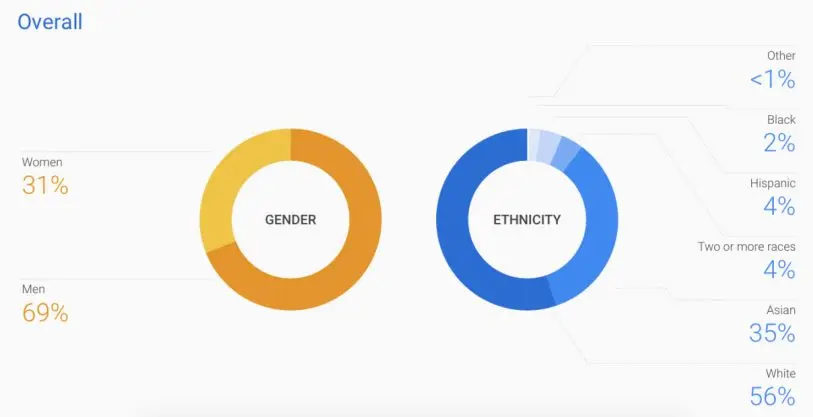Diversity, or lack thereof, is still a hot button issue in tech. Not having a balance of gender, age, race, etc. in any company can have far-reaching repercussions. Yet while an Uber exec recently scoffed at transparency, claiming such reporting does little to move the needle, Alphabet/Google continues to soldier on, releasing its latest report today.
The numbers still show that the company is largely white and male, and progress has been incremental. A blog post penned by Eileen Naughton, Google’s vice president of People Operations, asserts that women now make up 31% of employees. Those in tech roles have increased to 20%, and female leadership is now at 25%. Black employees in non-tech roles make up 5% of the total U.S. staff and Hispanics comprise 4%.

The tech giant pioneered the reporting of diversity numbers back in 2014 when it became the first major tech company to release data on the gender and ethnic makeup of its staff–visualized by a doodle. At that time, women made up 30% of the global workforce (of 73,000+) and held just 21% of leadership roles. Blacks and Hispanics combined comprised 5% of the U.S. team. Employees outside the U.S. are not required to self-report race and parent company Alphabet no longer shares U.S.-only or Google-only staff numbers.
Google subsequently invested $256 million on various efforts and initiatives to diversify its staff, including internships, computer labs for underserved middle school students, and the Howard West engineering residency sponsored by Google vice president Bonita Stewart. There’s also the ongoing Google in Residence initiative, which embeds Google engineers at historically black colleges and universities (HBCUs), and is aimed at tackling the pipeline problem. Yet as Naughton acknowledges, “clearly, there is much more to do.”
That’s why the report is accompanied by the announcement of a new vice president of diversity. Danielle Brown, the former vice president and chief diversity officer for Intel, starts in July. Brown has been on the front lines of Intel’s 5-year, $300 million plan to boost diversity and inclusion, which had started to shift the balance of a global staff of more than 107,000 employees. Biannual reporting revealed similar incremental gains, as well as areas for improvement, which drove new initiatives. As Brown told Fast Company this February, “We are not doubling in size every year,” so a 2% increase among 50,000 employees in the U.S. alone is a still a large number of people.
Brown faces a similar climb at Google, coupled with a demand for transparency. As Naughton writes, “More than other industries, the technology sector is extremely open about its challenges in creating a diverse and inclusive workforce. We all welcome the conversation and the scrutiny; it helps us raise the bar in terms of this important work and our commitment to it.”
Recognize your brand’s excellence by applying to this year’s Brands That Matter Awards before the early-rate deadline, May 3.
